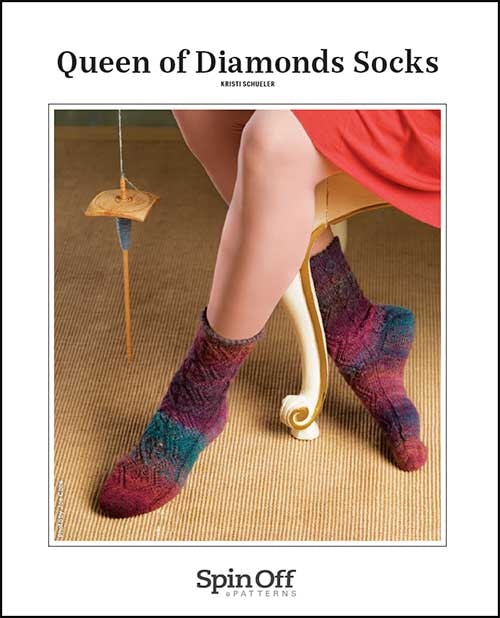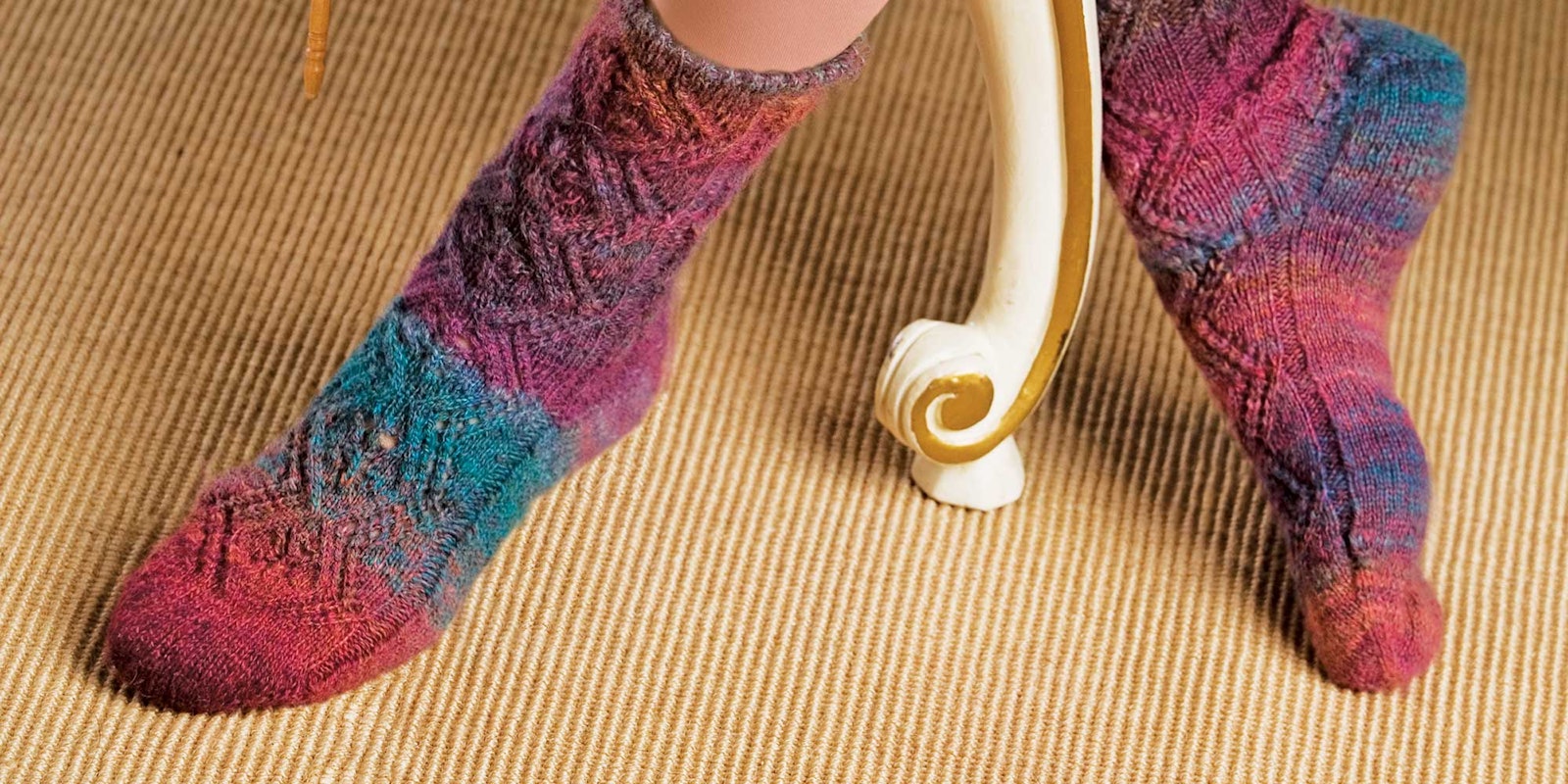Subscriber Exclusive
Food and Drink Dyes Can Yield Complex Colors?
These Queen of Diamond socks are brilliant, not only in their deep, rich color but also in their conception and toe-up construction. See how the author dyed, spun, and knitted this stunning pair, plus get the pattern!
These Queen of Diamond socks are brilliant, not only in their deep, rich color but also in their conception and toe-up construction. See how the author dyed, spun, and knitted this stunning pair, plus get the pattern! <a href="https://spinoffmagazine.com/food-and-drink-dyes-for-complex-colors/">Continue reading.</a>
https://spinoffmagazine.com/cdn-cgi/image/format=auto/https://www.datocms-assets.com/75073/1706292919-queen-of-diamonds-sock-header.jpg?auto=format&w=900
Not long after Kristi Schueler bought her first wheel, she was experimenting with Kool-aid dyeing for socks. Photos by Joe Coca unless otherwise noted
Using food and drink dyes can be an accessible and approachable way to try your hand at dyeing for the first time. While these dyes are often not considered to create deep, complex colors, Spin Off contributor Kristi Schueler clearly made it work! Keep in mind, more concentrated colors can be obtained by using gel dyes vs. liquid food coloring.
Kristi’s dyeing explorations resulted in a vivid, somewhat-striped yarn, which she then used to knit a fun pair of toe-up socks with diamond ribbing. We are excited to share Kristi’s article and toe-up sock pattern as this month’s subscriber bonus. Current Spin Off magazine subscribers can log in to access the downloadable PDF at the bottom of this post. Not a magazine subscriber? Learn more about all the perks.
Dyeing for an Ombré Effect
Having had experience dyeing her own yarn, Kristi decided to try her hand at dyeing fiber using Kool-aid and Wilton’s food coloring. Kristi first consulted a color wheel to help her decide on colors. She filled condiment squeeze bottles two-thirds full with one part white vinegar and one part warm water. She then mixed her dyes using various food colors and Kool-aid packets, tweaking until she got the colors she wanted.
After splitting her BFL top in two and soaking it in lukewarm water with a bit of dish soap for several hours, Kristi squeezed out the moisture and then applied the dyes in wide sections, which resulted in a somewhat striped effect. She then steamed, rinsed, and hung the top to dry.
Interested in more content on dyeing with food and drink dyes? In her article Handpainting Fiber: Exploring Food and Drink Dyes, Spin Off contributor Sukrita Mahon describes her method of dyeing handpainted tops and shares lots of great step-by-step photos.
 Left: A close look at the predrafted BFL top; right: the long lengths of colors in the singles are apparent as they relax on the bobbin. Photos courtesy of Kristi Schueler
Left: A close look at the predrafted BFL top; right: the long lengths of colors in the singles are apparent as they relax on the bobbin. Photos courtesy of Kristi Schueler
Spinning Notes
Kristi predrafted the fiber, then spun with a Z-twist using a semiworsted short-forward draw. Each section of top was spun on a single bobbin and then plied together to retain the color shifts created in the dyeing process. In the end, Kristi ended up with 350 yards of two-ply yarn with long gradual color shifts. Would the ombré effect become more apparant in the knitted pieces?
 Kristi says the ombré striping pattern attracted a lot of attention while she was knitting in public.
Kristi says the ombré striping pattern attracted a lot of attention while she was knitting in public.
Toe-Up Design and Sock Pattern Download
Kristi was nervous that she might not have enough yarn for knitting her standard socks, so she decided to use the toe-up sock knitting method using two circular needles. Kristi says, “The advantage of knitting from the toe up is that you can have the full pattern repeats no matter the length of the foot. It also allows you to make the most of the yarn you have and you can make the leg any length you desire as long as you have enough yarn.”
SUBSCRIBER EXCLUSIVE
Unlock the Full Article with a Spin Off Subscription
Get instant access to this article and the entire Spin Off library of projects, inspiration, and expert instruction. With your subscription, you’ll receive:
Master the art and science of spinning—from wheel mechanics to fiber prep
Learn from experienced spinners, dyers, and fiber artists in every issue
Explore in-depth tutorials, inspiring projects, and trusted techniques
Includes full access to print and digital issues of Spin Off Magazine
Spin Off explores the art and craft of making yarn. Each issue connects you to new and familiar voices in the handspinning community and is packed with information about fibers, tools, and traditions to inspire your creativity.
Plans start at just $4.99/month. Cancel anytime.
Using food and drink dyes can be an accessible and approachable way to try your hand at dyeing for the first time. While these dyes are often not considered to create deep, complex colors, Spin Off contributor Kristi Schueler clearly made it work! Keep in mind, more concentrated colors can be obtained by using gel dyes vs. liquid food coloring.
Kristi’s dyeing explorations resulted in a vivid, somewhat-striped yarn, which she then used to knit a fun pair of toe-up socks with diamond ribbing. We are excited to share Kristi’s article and toe-up sock pattern as this month’s subscriber bonus. Current Spin Off magazine subscribers can log in to access the downloadable PDF at the bottom of this post. Not a magazine subscriber? Learn more about all the perks.
Dyeing for an Ombré Effect
Having had experience dyeing her own yarn, Kristi decided to try her hand at dyeing fiber using Kool-aid and Wilton’s food coloring. Kristi first consulted a color wheel to help her decide on colors. She filled condiment squeeze bottles two-thirds full with one part white vinegar and one part warm water. She then mixed her dyes using various food colors and Kool-aid packets, tweaking until she got the colors she wanted.
After splitting her BFL top in two and soaking it in lukewarm water with a bit of dish soap for several hours, Kristi squeezed out the moisture and then applied the dyes in wide sections, which resulted in a somewhat striped effect. She then steamed, rinsed, and hung the top to dry.
Interested in more content on dyeing with food and drink dyes? In her article Handpainting Fiber: Exploring Food and Drink Dyes, Spin Off contributor Sukrita Mahon describes her method of dyeing handpainted tops and shares lots of great step-by-step photos.
 Left: A close look at the predrafted BFL top; right: the long lengths of colors in the singles are apparent as they relax on the bobbin. Photos courtesy of Kristi Schueler
Left: A close look at the predrafted BFL top; right: the long lengths of colors in the singles are apparent as they relax on the bobbin. Photos courtesy of Kristi Schueler
Spinning Notes
Kristi predrafted the fiber, then spun with a Z-twist using a semiworsted short-forward draw. Each section of top was spun on a single bobbin and then plied together to retain the color shifts created in the dyeing process. In the end, Kristi ended up with 350 yards of two-ply yarn with long gradual color shifts. Would the ombré effect become more apparant in the knitted pieces?
 Kristi says the ombré striping pattern attracted a lot of attention while she was knitting in public.
Kristi says the ombré striping pattern attracted a lot of attention while she was knitting in public.
Toe-Up Design and Sock Pattern Download
Kristi was nervous that she might not have enough yarn for knitting her standard socks, so she decided to use the toe-up sock knitting method using two circular needles. Kristi says, “The advantage of knitting from the toe up is that you can have the full pattern repeats no matter the length of the foot. It also allows you to make the most of the yarn you have and you can make the leg any length you desire as long as you have enough yarn.”[PAYWALL]

Click here to get the PDF download of the “Queen of Diamonds Socks” article and pattern.
Originally published Jan 29, 2024, updated October 16, 2025.
 Left: A close look at the predrafted BFL top; right: the long lengths of colors in the singles are apparent as they relax on the bobbin. Photos courtesy of Kristi Schueler
Left: A close look at the predrafted BFL top; right: the long lengths of colors in the singles are apparent as they relax on the bobbin. Photos courtesy of Kristi Schueler  Kristi says the ombré striping pattern attracted a lot of attention while she was knitting in public.
Kristi says the ombré striping pattern attracted a lot of attention while she was knitting in public. 

